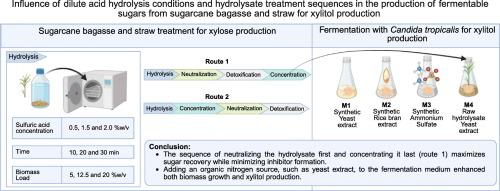Influence of dilute acid hydrolysis conditions and hydrolysate treatment sequences in the production of fermentable sugars from sugarcane bagasse and straw for xylitol production
Q1 Environmental Science
引用次数: 0
Abstract
The biotechnological production of xylitol has been widely studied in the literature; however, its industrial-scale implementation remains challenging due to non-standardized operating conditions and variations in processing sequences. This study evaluated key process conditions (acid concentration, biomass load, and reaction time) in two different hydrolysate production sequences using sugarcane bagasse and straw mixture. The results showed that the sequence in which the hydrolysate was neutralized in the first step and concentrated in the last step resulted in higher sugar recovery and less formation of inhibitors. The optimal conditions were identified as 2 % (w/v) sulfuric acid, biomass load of 5 % (w/v), and reaction time of 30 min. Fermentation of the raw hydrolysate obtained under these optimal conditions presented inhibition in xylitol production, but supported biomass growth, possibly due to the carbon-to‑nitrogen ratio in the medium. Further assays revealed that the addition of an organic nitrogen source (yeast extract) to the medium enhanced biomass growth and xylitol production. Based on the results, an alternative process sequence with hydrolysis conditions optimized to maximize xylose recovery was proposed. Additionally, the combined synergistic effects of inhibitors (acetic acid, formic acid, furans, and phenols) on the metabolism of Candida tropicalis were also studied.

稀酸水解条件和水解产物处理顺序对甘蔗甘蔗渣和秸秆发酵糖生产木糖醇的影响
木糖醇的生物技术生产已经得到了广泛的研究。然而,由于非标准化的操作条件和处理顺序的变化,其工业规模的实施仍然具有挑战性。本研究评估了蔗渣和秸秆混合物在两种不同水解产物生产序列中的关键工艺条件(酸浓度、生物量负荷和反应时间)。结果表明,水解产物在第一步中和,在最后一步浓缩的顺序可以获得更高的糖回收率和较少的抑制剂形成。最佳条件为硫酸浓度为2% (w/v),生物质负荷为5% (w/v),反应时间为30 min。在此最佳条件下发酵得到的原料水解液对木糖醇的生产有抑制作用,但对生物量的生长有促进作用,这可能与培养基中的碳氮比有关。进一步的实验表明,在培养基中添加有机氮源(酵母提取物)促进了生物量的生长和木糖醇的产量。在此基础上,提出了优化水解条件的替代工艺序列,以最大限度地提高木糖的回收率。此外,还研究了抑制剂(乙酸、甲酸、呋喃和酚类)对热带假丝酵母代谢的联合协同作用。
本文章由计算机程序翻译,如有差异,请以英文原文为准。
求助全文
约1分钟内获得全文
求助全文
来源期刊

Bioresource Technology Reports
Environmental Science-Environmental Engineering
CiteScore
7.20
自引率
0.00%
发文量
390
审稿时长
28 days
 求助内容:
求助内容: 应助结果提醒方式:
应助结果提醒方式:


